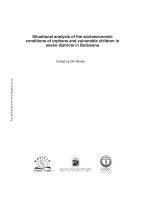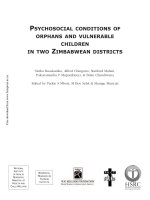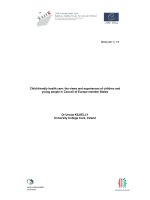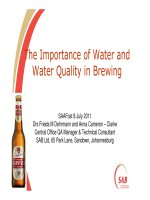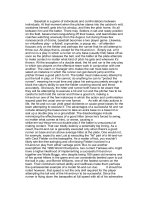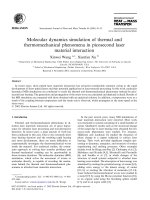Molecular simulations of biofuel and water purification in metal organic frameworks
Bạn đang xem bản rút gọn của tài liệu. Xem và tải ngay bản đầy đủ của tài liệu tại đây (5.86 MB, 157 trang )
MOLECULAR SIMULATIONS OF BIOFUEL AND WATER
PURIFICATION IN METAL–ORGANIC FRAMEWORKS
NALAPARAJU ANJAIAH
NATIONAL UNIVERSITY OF SINGAPORE
2012
MOLECULAR SIMULATIONS OF BIOFUEL AND WATER
PURIFICATION IN METAL–ORGANIC FRAMEWORKS
NALAPARAJU ANJAIAH
(M.Tech., IIT Kanpur)
A THESIS SUBMITTED
FOR THE DEGREE OF DOCTOR OF PHILOSOPHY
DEPARTMENT OF CHEMICAL AND BIOMOLECULAR
ENGINEERING
NATIONAL UNIVERSITY OF SINGAPORE
2012
Acknowledgements
This thesis would have not been possible without the steady support, impeccable
guidance and encouragement from my supervisor, Prof. Jiang Jianwen. I have been
fortunate to pursue my PhD under such splendid supervision. I owe my deepest gratitude
to him for the patience and understanding showed to me throughout my PhD program.
Under his supervision, I have learnt the true essence of being “creative, proactive,
persistent and skillful” to tackle research problems. Undoubtedly, I treasure this
experience in all my future endeavors.
I owe a significant debt to all present and former members of Prof. Jiang’s research
group for being there as a precious source to discuss technical aspects and also to have
refreshing chitchats. I cherish all the priceless moments in the group meetings and
activities. I wish to make special thanks to Dr. Hu Zhongqiao, Dr. Babarao Ravichandar
and Ms. Chen Yifei for sharing their invaluable knowledge and also for providing timely
helps on several occasions.
I am grateful to National University of Singapore for providing me the research
scholarship to pursue doctoral study. I also express special thanks to all faculty and staff
in the department (ChBE) for offering an enriching academic and social environment. I
am thankful to the reviewers for spending time on evaluating my thesis.
I would like to express my deepest gratitude to many people who all together created
a homely environment and made my stay in Singapore pleasant and memorable. I would
like to particularly express my heartfelt gratitude to Sint for looking after me more than
like a family member. I am very much indebted to her continuous support and
encouragement. Without her help, it would have been difficult to overcome the tough
i
phases of my study and research. I would like to specially thank my flatmates for their
help and understanding, particularly during difficult times.
I am deeply indebted to my parents and family members for their endless love and
support. Their well wishes have always been a great strength to me at all stages of my
life. To them I dedicate this thesis. Acknowledgements are also due to my friends and
teachers in all stages of my academic life. In addition to those already mentioned, I am
grateful to each and everyone who directly or indirectly helped me to complete this
thesis.
Finally, I thank almighty God for giving me this opportunity and offering me enough
strength to finish my PhD program.
Anjaiah Nalaparaju
ii
Table of Contents
Acknowledgements i
Table of Contents iii
Summary vi
List of Tables ix
List of Figures x
Abbreviations xv
Chapter 1. Introduction 1
1.1 Metal
−Organic Frameworks 1
1.1.1 Diversity in Design of MOFs 5
1.2 Multifunctional Properties of MOFs 9
1.2.1 Gas Storage 10
1.2.2 Gas/Vapor Separation 11
1.2.3 Liquid Separation 13
1.2.4 Ion Exchange 16
1.2.5 Catalysis 17
1.2.6 Water-Containing Systems 18
1.3 Literature Review 20
1.3.1 Studies beyond Gas Storage and Separation 21
1.3.2 Studies on Water-Containing Systems 22
1.4 Simulation Methodology 25
1.4.2 Monte Carlo 27
1.4.2 Molecular Dynamics 29
1.5 Scope of the Thesis 30
1.6 Organization of the Thesis 31
iii
Chapter 2. Water in Ion-Exchanged Zeolite-like MOFs 32
2.1 Introduction 32
2.2 Models and Methods 35
2.3 Results and Discussion 40
2.3.1 Locations and Dynamics of Na
+
Ions 41
2.3.2 Adsorption of Water 42
2.3.3 Mobility of Water 49
2.3.4 Vibration of Water 51
2.4 Conclusions 53
Chapter 3. Water and Alcohols in Hydrophilic and Hydrophobic Zeolitic MOFs 55
3.1 Introduction 55
3.2 Models and Methods 58
3.3 Results and Discussion 62
3.3.1 Pure components in Na-rho-ZMOF 62
3.3.2 Binary mixtures in Na-rho-ZMOF 66
3.3.3 Pure components in ZIF-71 68
3.3.4 Binary mixtures in ZIF-71 71
3.4 Conclusions 73
Chapter 4. Biofuel Purification in MOFs 76
4.1 Introduction 76
4.2 Models and Methods 79
4.3 Results and Discussion 82
4.3.1 Adsorption in Na-rho-ZMOF 83
4.3.2 Adsorption in Zn
4
O(bdc)(bpz)
2
88
4.3.3 Diffusion in Na-rho-ZMOF 91
4.3.4 Diffusion in Zn
4
O(bdc)(bpz)
2
94
4.3.5 Permselectivity 96
4.4 Conclusions 98
iv
Chapter 5. Water Purification in rho Zeolite-like MOF 99
5.1 Introduction 99
5.2 Simulation Models and Methods 101
5.3 Results and discussion 104
5.3.1 Ion exchange process 105
5.3.2 Ions in rho-ZMOF 109
5.4 Conclusions 113
Chapter 6. Conclusions and Future Work 115
6.1 Conclusions 115
6.2 Future Work 118
References 121
Publications 136
Presentations 137
Appendix……………………………………………………………………………….138
v
Summary
In the last decade, metal−organic frameworks (MOFs) have emerged as a versatile
class of hybrid nanoporous materials. Compared with zeolites, an exceptional degree of
design tunability can be achieved in MOFs by judicious selection of inorganic and
organic components, or via post-synthetic modifications. The possibilities of using MOFs
have been realized in most applications where zeolites have been employed; however,
major progress is achieved only on gas storage and separation applications. Recently,
attention is turning towards employing MOFs in liquid-phase separation such as biofuel
and water purification. For the facile usage of MOFs in these applications, it is of central
importance to understand the chemical stability and properties of MOFs in aqueous
environment. While a number of studies have investigated the stability of MOFs under
humid atmosphere, very little is known about how MOFs interact with water and perform
in water-containing applications. The pathway from laboratory synthesis and testing to
practical utilization of MOF materials is substantially challenging and requires
fundamental understanding from the bottom up.
With ever-growing computational resources, molecular simulation has become an
invaluable tool for materials characterization, screening and design. At a molecular level,
simulation can provide microscopic insights from the bottom-up and establish structure-
function relationships. In this thesis, the objectives are to investigate biofuel and water
purification in chemically and thermally stable MOFs by molecular simulation. As an
initial step, the microscopic properties of water and alcohols in MOFs are examined. The
whole thesis primarily consists of four parts:
vi
(1) The adsorption, mobility and vibration of water in ion-exchanged rho zeolite-like
MOF (ZMOF) are investigated. Because of the high affinity for nonframework ions,
water is strongly adsorbed in rho-ZMOF with a three-step adsorption mechanism. Upon
water adsorption, Na
+
cations are redistributed among different favorable sites and the
mobility of ions is promoted, which reveals the subtle interplay between water and
nonframework ions. The adsorption capacity and isosteric heat decrease with increasing
ionic radius, as attributed to the reduced electrostatic interaction and free volume. The
mobility of water in rho-ZMOF increases at low pressures but decreases upon
approaching saturation. The vibrational spectra of water in Na-rho-ZMOF exhibit distinct
bands corresponding to the librational motion, bending, and stretching of adsorbed water
molecules.
(2) The adsorption of water and alcohols (methanol and ethanol) is investigated in
two MOFs topologically similar to rho-zeolite, one is hydrophilic Na
+
-exchanged rho
zeolite-like MOF (Na-rho-ZMOF) and the other is hydrophobic zeolitic-imidazolate
framework-71 (ZIF-71). The adsorption isotherms in Na-rho-ZMOF are type I as a
consequence of the high affinity of adsorbates with framework. In water/methanol and
water/ethanol mixtures, water adsorption increases continuously with increasing pressure
and replaces alcohols competitively at high pressures. In ZIF-71, the framework-
adsorbate affinity is relatively weaker and type V adsorption is observed. In
water/alcohol mixtures, alcohols are selectively more adsorbed at low pressures, but
surpassed by water with increasing pressure. The framework charges have a substantial
effect on adsorption in Na-rho-ZMOF, but not in ZIF-71.
vii
(3) Biofuel (water/ethanol mixtures) purification is studied in two MOFs, hydrophilic
Na-rho-ZMOF and hydrophobic Zn
4
O(bdc)(bpz)
2
at both pervaporation (PV) and vapor
permeation (VP) conditions. In Na-rho-ZMOF, water is preferentially adsorbed over
ethanol and the diffusion selectivity of water/ethanol increases in Na-rho-ZMOF with
increasing water composition. In contrast, ethanol is adsorbed more in Zn
4
O(bdc)(bpz)
2
and the diffusion selectivity of ethanol/water decreases slightly in Zn
4
O(bdc)(bpz)
2
with
increasing water composition. The permselectivities in the two MOFs at both PV and VP
conditions are largely determined by the adsorption selectivities. Na-rho-ZMOF is
preferable to remove a small fraction of water from water/ethanol mixtures and enrich
ethanol at the feed side and Zn
4
O(bdc)(bpz)
2
is promising to extract a small fraction of
ethanol and enrich ethanol at the permeate side.
(4) Removal of toxic Pb
2+
ions from water for purification is investigated. In rho
ZMOF with nonframework Na
+
ions, ion exchange between Na
+
and Pb
2+
ions is
observed from simulation. By umbrella sampling, the potential of mean force for Pb
2+
is
estimated to be −10 k
B
T, which is more favorable than −5 k
B
T for Na
+
and contributes to
the observed ion exchange. The residence-time distributions and mean-squared
displacements reveal that all the exchanged Pb
2+
ions stay exclusively in rho-ZMOF
without exchanging with other ions in solution due to the strong interaction with rho-
ZMOF; however, Na
+
ions have a shorter residence time and a larger mobility than Pb
2+
ions.
viii
List of Tables
Table 2.1
Potential parameters for water atoms (OW and HW), ions (Li
+
,
Na
+
and Cs
+
) and framework atoms (In, N, O, C and H).
38
Table 3.1
Potential parameters of adsorbates (water, methanol and ethanol). 60
Table 5.1
Lennard-Jones parameters of framework atoms and heavy metal
ions.
103
ix
List of Figures
Figure 1.1
Synthesis of MOF-5 and Cu-BTC from molecular building blocks. 3
Figure 1.2
Application-oriented properties of MOFs with prototypical
linkers.
10
Figure 1.3
Number of publications for MOFs (from the ISI web of science). 20
Figure 2.1
(a) Eight-coordinated molecular building block. (b) Atomic
charges in a fragmental cluster of rho-ZMOF. Color code: In,
cyan; N, blue; C, grey; O, red; and H, white.
36
Figure 2.2
Locations of Na
+
ions in Na-rho-ZMOF. Site I (green) is at the
single eight-membered ring (S8MR), while site II (orange) is in
the α-cage. (a) unit cell and (b) eight-membered ring and α-cage.
Color code: In, cyan; N, blue; C, grey; O, red; and H, white. (c)
Mean squared displacements of Na
+
ions.
41
Figure 2.3
Density contours of water in Na-rho-ZMOF at 10
-8
, 10
-2
and 1
kPa. Na
+
ions are represented by the large pink spheres. The
density is based on the number of water molecules per Å
3
.
43
Figure 2.4
Radial distribution functions of (a) Na
I
+
-OW (b) Na
II
+
-OW (c)
OW-OW in Na-rho-ZMOF at 10
-8
, 10
-2
, 0.1 and 1 kPa. For
comparison, g(r) of OW-OW in bulk water is included as the
dashed line in (c).
43
Figure 2.5
Coordination numbers of water around (a) Na
I
+
and (b) Na
II
+
in
Na-rho-ZMOF at 10
-8
, 10
-2
, 0.1 and 1 kPa.
45
Figure 2.6
(a) Adsorption isotherms of water in Li-, Na- and Cs-exchanged
rho-ZMOF as a function of pressure. The inset shows the numbers
of Na
I
+
and Na
II
+
as function of water loading in Na-rho-ZMOF.
(b) Adsorption isotherms of water in Li-, Na- and Cs-exchanged
rho-ZMOF at low-pressure regime.
46
Figure 2.7
Calculated isosteric heats of water adsorption in Li-, Na- and Cs-
exchanged rho-ZMOF as a function of loading.
47
Figure 2.8
Locations of water in the single 8-membered ring in Li-, Na- and
Cs-exchanged rho-ZMOF at 10
-8
kPa. Color code: In, cyan; N,
blue; C, grey; O, red; H, white; Li
+
, yellow; Na
+
, green; and Cs
+
,
pink. The distances between water and ions are in Angstroms.
49
x
Figure 2.9
(a) Mean-squared displacements of water and (b) Na
+
ions in Na-
rho-ZMOF at various pressures.
50
Figure 2.10
Vibrational spectra of water in Na-rho-ZMOF at various pressures
and in bulk water.
51
Figure 3.1
Pore morphologies and radii in (a) Na-rho-ZMOF and (b) ZIF-71.
Color code: In/Zn, cyan; N, blue; C, grey; O, red; Cl, green; and
H, white; and Na
+
, purple.
57
Figure 3.2
Unit cells of (a) rho-ZMOF and (b) ZIF-71. Color code: In/Zn,
cyan; N, blue; C, grey; O, red; Cl, green; and H, white. The
nonframework Na
+
ions in rho-ZMOF are not shown.
58
Figure 3.3
(a) four-coordinated molecular building block. (b) Atomic charges
in the fragmental clusters ZIF-71. Color code: Zn, cyan; N, blue;
C, grey; O, red; Cl, green; and H, white.
59
Figure 3.4
Zeolite-analogue representation of (a) Na-rho-ZMOF and (b) ZIF-
71. Two types of binding sites exist for Na
+
ions in Na-rho-
ZMOF, in which site I (pink) is at the single eight-membered ring
(S8MR) and site II (yellow) is in the α-cage. The two S8MRs
form a double eight-membered ring (D8MR).
60
Figure 3.5
Adsorption isotherms of water, methanol, and ethanol in Na-rho-
ZMOF. The inset shows the isotherms in the linear scale of
pressure. The saturation pressure is 3.1 kPa for water, 16.8 kPa for
methanol, and 7.2 kPa for ethanol.
62
Figure 3.6
Radial distribution functions g(r) of (a) Na
+
-adsorbate (b) O
2
-
adsorbate (c) In-adsorbate for water, methanol, and ethanol in Na-
rho-ZMOF at 10
-4
kPa. O
2
is the carboxylic oxygen atom of the
framework as shown in Figure 3.3.
63
Figure 3.7
Density contours of water, methanol, and ethanol in Na-rho-
ZMOF at 10
-4
kPa. The density is based on the number of
molecules per Å
3
. The large pink spheres indicate Na
+
ions. The
dotted circles indicate the single-eight membered rings (S8MRs).
65
Figure 3.8
Adsorption isotherms for the equimolar mixtures of (a)
water/methanol (b) water/ethanol in Na-rho-ZMOF. (c)
Selectivities.
66
Figure 3.9
Radial distribution functions g(r) of In-adsorbate for the
equimolar mixtures of (a) water/methanol (b) water/ethanol in Na-
rho-ZMOF at 10
-4
kPa.
67
xi
Figure 3.10
Adsorption (filled symbols) and desorption (open symbols)
isotherms of water, methanol, and ethanol in ZIF-71 as a function
of (a) pressure and (b) reduced pressure. The saturation pressure
P
o
is 3.1 kPa for water, 16.8 kPa for methanol, and 7.2 kPa for
ethanol.
69
Figure 3.11
Density contours of methanol in ZIF-71 at 13, 14, and 15 kPa,
respectively.
70
Figure 3.12
Radial distribution functions g(r) of (a) Zn-water (b) Zn-methanol
and (c) Zn-ethanol for water, methanol, and ethanol in ZIF-71.
70
Figure 3.13
Adsorption isotherms for the equimolar mixtures of (a)
water/methanol (b) water/ethanol in ZIF-71. (c) Selectivities.
71
Figure 3.14
Radial distribution functions g(r) of Zn-adsorbate for the
equimolar mixtures of (a) water/methanol at 16 kPa (b)
water/ethanol at 10 kPa in ZIF-71.
72
Figure 3.15
Adsorption isotherms for the equimolar mixture of water/ethanol
in (a) Na-rho-ZMOF and (b) ZIF-71 with and without the
framework charges.
73
Figure 4.1
Atomic structures of (a) Na-rho-ZMOF and (b) Zn
4
O(bdc)(bpz)
2
.
Color code: In, cyan; N, blue; Zn, green; C, grey; O, red; H,
white; Na
+
ions, orange.
79
Figure 4.2
(a) Atomic charges in the fragmental clusters of Zn
4
O(bdc)(bpz)
2
.
(b) Adsorption isotherms of methanol in Zn
4
O(bdc)(bpz)
2
at 298
K. The open diamonds are the simulation results of this work, and
the filled diamonds are experimental data.
80
Figure 4.3
Adsorption selectivities for water/ethanol mixtures in Na-rho-
ZMOF at PV and VP conditions. The insets are adsorption
isotherms.
83
Figure 4.4
Density contours of water and ethanol for water/ethanol mixture
(10:90) at PV condition in Na-rho-ZMOF.
84
Figure 4.5
Radial distribution functions of (a) Na
+
-adsorbates, (b) O
2
-
adsorbates, and (c) In-adsorbates. (d) Coordination numbers of
water and ethanol around Na
+
ions for water/ethanol mixture
(10:90) at PV condition in Na-rho-ZMOF.
85
xii
Figure 4.6
Radial distribution functions of (a) Na
+
-OW (OH), (b) O
2
-OW
(OH), and (c) In-OW (OH) for water/ethanol mixture (10:90) at
PV condition in Na-rho-ZMOF. OW and OH are the oxygen
atoms in water and ethanol, respectively.
87
Figure 4.7
Radial distribution functions of (a) O
water
-H
ethanol
, O
water
-H
water
and
O
ethanol
-H
ethanol
for water/ethanol equimolar mixture at PV
condition. (b) O
water
-H
ethanol
at PV condition and (c) O
water
-H
ethanol
at VP condition with various feed compositions in Na-rho-ZMOF.
88
Figure 4.8
Adsorption selectivities for ethanol/water mixtures in
Zn
4
O(bdc)(bpz)
2
at PV and VP conditions. The insets are
adsorption isotherms.
89
Figure 4.9
Density contours of ethanol and water for ethanol/water mixture
(10:90) at PV condition in Zn
4
O(bdc)(bpz)
2
89
Figure 4.10
Radial distribution functions of (a) Zn-adsorbates, (b) C
6
-
adsorbates, and (c) C
3
-adsorbates for ethanol/water mixture
(10:90) at PV condition in Zn
4
O(bdc)(bpz)
2
.
90
Figure 4.11
Radial distribution functions of (a) O
water
-H
ethanol
, O
water
-H
water
and
O
ethanol
-H
ethanol
for water/ethanol equimolar mixture at PV
condition. (b) O
water
-H
ethanol
at PV condition and (c) O
water
-H
ethanol
at VP condition with various feed compositions in
Zn
4
O(bdc)(bpz)
2
.
91
Figure 4.12
Mean-squared displacements for water/ethanol mixtures in Na-
rho-ZMOF with various feed compositions.
92
Figure 4.13
Mean-squared displacements on the log-scale for water/ethanol
mixtures in Na-rho-ZMOF with various feed compositions.
93
Figure 4.14
Diffusivities at (a) PV and (b) VP conditions. (c) Diffusion
selectivities for water/ethanol mixtures in Na-rho-ZMOF.
94
Figure 4.15
Mean-squared displacements for ethanol/water mixtures in
Zn
4
O(bdc)(bpz)
2
with various feed compositions.
94
Figure 4.16
Mean-squared displacements on the log-scale for ethanol/water
mixtures in Zn
4
O(bdc)(bpz)
2
with various feed compositions.
95
Figure 4.17
Diffusivities at (a) PV and (b) VP conditions. (c) Diffusion
selectivities for ethanol/water mixtures in Zn
4
O(bdc)(bpz)
2
.
96
xiii
Figure 4.18
Permselectivities for water/ethanol mixtures in Na-rho-ZMOF and
Zn
4
O(bdc)(bpz)
2
.
97
Figure 5.1
Unit cell of rho-ZMOF (nonframework ions are not shown). The
8-membered ring (8MR), 6-membered ring (6MR) and 4-
membered ring (4MR) are indicated. Color code: In, cyan; N,
blue; C, grey; O, red; and H, white.
102
Figure 5.2
Snapshots of simulation system (a) t = 0 (b) t = 0.2 ns and (c) t = 2
ns. Color code: Pb
2+
: orange; Cl
−
: green; Na
+
: blue.
105
Figure 5.3
Numbers of Na
+
, Pb
2+
and Cl
−
ions in Na-rho-ZMOF as a function
of simulation duration.
106
Figure 5.4
Density profiles of Na
+
, Pb
2+
and Cl
−
ions at (a) t = 0 (b) t = 0.2 ns
and (c) t = 2 ns. The dotted-dashed line indicates solution/rho-
ZMOF interface.
107
Figure 5.5
Potentials of mean force (PMFs) for Na
+
, Pb
2+
and Cl
−
ions
moving from solution to rho-ZMOF. The dotted-dashed line
indicates the solution/rho-ZMOF interface.
108
Figure 5.6
Radial distribution functions of Na
+
and Pb
2+
ions around the
framework atoms (a) In (b) O
1
and (c) O
2.
The insets show the
coordination numbers of ions around the framework atoms.
110
Figure 5.7
(a) Residence time distributions and (b) mean-squared
displacements of Pb
2+
and Na
+
ions in rho-ZMOF.
111
Figure 5.8
(a) Mean-squared displacements and (b) velocity autocorrelation
functions of Pb
2+
ions in rho-ZMOF framework. Pb
2+
in 8MR:
pink; Pb
2+
in 6MR, brown; Pb
2+
in 4MR, orange.
112
xiv
Abbreviations
MOFs
Metal−Organic Frameworks
MOF-n
Metal−Organic Framework (with n an integer assigned in roughly
chronological order)
IRMOF
Isoreticular Metal−Organic Framework
MIL Materials of Institut Lavoisier
PCN Porous Coordination Network
UMCM University of Michigan Crystalline Material
CUK Cambridge University-KRICT
POST-1 Pohang University of Science and Technology-1
PIZA Porphyrinic Illinois Zeolite Analogue
ISE Institut Solare Energiesysteme
MFU Metal-Organic Framework Ulm University
DUT Dresden University of Technology
ZIF-n Zeolitic Imidazolate Framework (with n an integer assigned in roughly
chronological order)
ZMOFs Zeolite-like Metal Organic Frameworks
soc
Square Octahedral
MFI Mobil Five
BEA Zeolite Beta
MOR Mordenite
FAU Faujasite
ETS-10 Engelhard TitanoSilicate-10
SBU Secondary Building Unit
TBUs Tetrahedral Building Units
BDC Benzene Dicarboxylate
BTC Benzene Tricarboxylate
ImDC Imidazolate Dicarboxylate
BPZ Bipyrazolate
PDA Phenylenediacetate
xv
PZDC Pyrazinedicarboxylate
BPEE Bispyridylethene
DOE Department of Energy
MC Monte Carlo
MD Molecular Dynamics
MSD Mean Squared Displacement
GCMC Grand Canonical Monte Carlo
DFT Density Functional Theory
B3LYP Becke’s three parameter, Lee, Yang and Parr
CVFF Consistent Valence Fore Field
TIP3P/Fs Flexible Three Point Transferable Interaction Potential
TraPPE Transferrable Potentials for Phase Equlibria
FF Force Field
UFF Universal Force Field
LJ Lennard-Jones
LB Lorentz-Berthelot
ESP ElectroStatic Potential
D8R Double eight Ring
S8R Single eight Ring
VP Vapor Permeation
PV Pervaporation
xvi
Chapter 1. Introduction
Chapter 1
Introduction
1.1 Metal-Organic Frameworks
Nanoporous materials are an intriguing family of solid-state matter. The structures of
these materials constitute a solid skeleton, which is usually described in terms of building
units formed by the assembly of atoms, ions, or molecules, and a porous space of
nanoscale. The porous space can act as an excellent platform to carry out reactions and
separations with high specificity in chemical, petrochemical and pharmaceutical
industries.
1
Since the discovery by Cronstedt in 1756, zeolites have been dominating the
realm of nanoporous materials due to their unique pores and structural stability.
2
The pore
size distribution in zeolites is narrower compared with other porous materials such as
activated carbon, silica gel and activated alumina. The frameworks of zeolites are purely
inorganic and constructed by oxygen bridged tetrahedral units of silica and aluminum.
Zeolites have been used as size- and shape-selective molecular sieves in catalysis, as well
in chemical separation and ion exchange.
3
However, the applications of zeolites have
been confined only to specific operations, largely due to the limitation in enlarging pore
sizes and less possibility to tailor the functionality of pore walls.
4,5
For example, the small
pore size of zeolites is usually underlined as a key limitation in the catalytic
transformation of large molecules (e.g. polyaromatics and carbohydrates) and the
incorporation of transition elements. To develop new nanoporous materials of zeotype,
several approaches have been implemented, such as varying primary building units to
octahedrals, isomorphous substitution of other metal atoms, varying anions from O
2-
,
1
Chapter 1. Introduction
using templates to generate larger rings and scale chemistry to change the size of building
units. Several such strategies have been used to design new inorganic nanoporous
materials with improved properties.
6
In addition, organic functionalized zeolites also have
been developed by applying appropriate functional groups as pendants onto the pore
surfaces and also by partially incorporating into zeolitic frameworks to achieve selective
host-guest interactions and heterogeneous catalysis.
7
In supramolecular chemistry, one objective is to design new porous materials with
predesigned molecular units. Consequently, the shape, size and functionality of the pores
become more tunable.
8
However, a major difficulty in synthesizing porous solids based
on molecular units is the isotropic interactions among organic molecules that usually lead
to the closest packings.
9
Moreover, the network constructed by directional interactions
with intention to create large cavities tends to self-interpenetrate in the voids of initial
host structure and finally results in a dense structure. In early 1990’s, Robson and
coworkers produced an expanded diamondiod network with a 10.5 Å pore through the
deliberate connection of tetrahedral building units formed by Cu
+
node and nitrogen-
donor 4,4′,4″,4″′-tetracyanotetraphenylmethane.
10
No interpenetration occurred in this
framework and guest anions were readily exchanged with other ions. Following this
work, a vast array of structures have been reported based on neutral nitrogen-donor
ligands, particularly by using 4,4′-bipyridine (BPY).
11
However, the structures based on
metal-BPY have several shortcomings, e.g., inclusion of a counterion was necessary,
interpenetration was common, and thermal stability was often low (below 250
o
C),
especially upon guest removal. Subsequently, the success in use of anionic, polydentate
rigid carboxylate linkers such as benzene-1,3,5-tricarboxylate (BTC) and benzene-1,4-
2
Chapter 1. Introduction
dicarboxylate (BDC) opened the era of reticular synthesis.
12
The strength of these
building units arises from the enhanced electrostatic attractions and the size of
carboxylate functionality permits the chelation of metal cations to produce rigid,
geometrically defined clusters, which are termed as secondary building units (SBU). The
yielded neutral, non-interpenetrated networks maintain crystallinity during exchange or
complete removal of guests and the decomposition temperatures are up to 500
o
C. Figure
1.1 illustrate the synthesis of two earliest MOFs, namely MOF-5
13
and Cu-BTC.
14
MOF-
5 is prototypical framework constructed by Zn
4
O(CO
2
)
6
clusters connected with BDC
linkers. Cu-BTC is formed by bimetallic “paddle wheel” Cu
2+
clusters connected in a
trigonal fashion by BTC linkers.
Figure 1.1. Synthesis of MOF-5 and Cu-BTC from molecular building blocks.
15
Reproduced with
permission of the Royal Society of Chemistry (Appendix).
These robust MOFs are stable even after the removal and re-sorption of guest
molecules, showing zeolites-like structures with permanent porosity. The access to this
porosity is limited by the dimensions of pore windows rather than the cavities in the
structures. Kitagawa and coworkers categorized them as the 2
nd
generation nanoporous
materials.
16
In contrast, the 3
rd
generation MOFs have flexible and dynamic frameworks
3
Chapter 1. Introduction
that can respond to external stimuli such as light, electric field, gust molecules, and
change pore size reversibly. As an early example, Kitagawa et al. reported a 3D
crystalline pillared layer (CPL) [Cu
2
(pyrazine-2,3-dicarboxylate)(1,2-
dipyridylglycol).8H
2
O]
n
(CPL-7), which shows a reversible crystal-to-crystal
transformation on adsorption and desorption of H
2
O or MeOH.
17
Upon dehydration, the
3D framework undergoes a pore contraction and the layer-layer distance drastically
reduces to 9.6 Å from 13.2 Å. This drastic structural alternation influences sorption
properties. As a consequence, N
2
and CH
4
cannot diffuse into the micropore of CPL-7,
but H
2
O and MeOH can diffuse albeit the pore size is smaller than MeOH molecule.
Another example of dynamic MOF reported by Ferey et al. is MIL-53 (MIL = Materials
of Institut Lavoisier). As a chromium dicarboxylate based MOF, MIL-53 exhibits a very
large breathing upon hydration from MIL-53lt (lt = low temperature) to MIL-53ht (ht =
high temperature). This phenomenon is not pronounced in vanadium based MIL-47,
which is structural analogues to MIL-53.
18
The salient strength of MOFs is not their thermal stability and in this aspect they
cannot outperform than zeolites. Instead, the functionalization of organic linkers in MOFs
or the direct incorporation of functional groups create unique porous solids that contain
different groups capable of binding guests and/or catalyzing chemical reactions.
19
Especially by imparting chiral functionality and reactive groups, desired attributes can be
obtained in a periodic manner throughout MOFs. Synthesis of chiral molecular sieves
from polyhedral oxide is difficult, whereas homochiral MOFs are much straightforward
to be produced by simply employing enantiomerically pure links. Kim et al. reported an
enantiopure Zn-based framework POST-1, in which pyridinium functional groups are
4
Chapter 1. Introduction
protruded into the chiral channels.
20
These pyridine groups undergo exchange of protons
with alkali metal ions or other ions. Attributed to the chiral environment, POST-1 can
discriminate cationic enantiomers of [Ru(2,2′-bipy)
3
]
2+
. They also found that immersion
of L-POST-1 in a methanolic solution of racemic [Ru(2,2′-bipy)
3
]
2+
led to a change in
crystal color from white to reddish yellow, and 80% of protons were exchanged by
[Ru(2,2′-bipy)
3
]
2+
.
1.1.1 Diversity in Design of MOFs
The field of MOFs has achieved an accelerated and sustained growth as reflected in
two aspects: the new generation of ingenious topological structures and the potential
applications in emerging areas.
21
Developments related to the former will be discussed
below and the latter will be discussed in the next section.
Among a range of design principles, two approaches have been widely used to direct
the synthesis of MOFs with desired topology and/or functionality. The first is ‘node and
spacer’ approach, in which a net is usually constructed by metal-based node and organic
spacer.
22
The node could be square, tetrahedral, octahedral, etc. The resultant network
topology is dependent on the geometry and coordination environment of the node as the
spacer is simply a linear connection between adjacent nodes. The second is reticular
approach based on the secondary building unit (SBU) that is molecular polygon or
polyhedron of metal cluster or molecular complex.
23
The network topology formed from
this approach is mainly determined by the geometry of the pairing SBU. Although SBUs
can be found in discrete molecules, only in situ formed SBUs have been exploited in the
MOF synthesis. In each approach, the concept of using multitopic ligand of specific
geometry to link metal ions or metal ion clusters with specific coordination preference is
5
Chapter 1. Introduction
common.
24
Using these approaches by deliberately choosing molecular building units, it
is possible to explore the generation of three dimensional networks of varying known and
unknown topologies.
In terms of the degree of chemical diversity compared with inorganic porous solids,
MOFs allow a wider variety of coordination number ranging from 2 to 7 for transition
metal ions and 7 to 10 for lanthanide ions. This feature, associated with the large choice
of neutral and/or anionic functionalized organic linkers with possible chelation or single
boding, provides a myriad of new MOFs.
16
An infinite number of materials can be
designed by employing variations in both inorganic and organic building units. For
example, inorganic building blocks in the SBU approach can be molecular
triangle/triangular prism, square planar, octahedron, etc.; organic linkers may contain
donors of O (polycarboxylates, polyphosponates) and N (imidazolates, polypyrazolates,
polytetrazolates).
25
MOFs represent a breakthrough in materials chemistry since they
combine all the desired possibilities occurring in other nanoporous solids with the
tunability on all structural characteristics such as skeleton, surface and cage, thus leading
to unlimited pore sizes and surface areas.
26,27
Similar to isomorphic substitution in
zeolites, the principle of isoreticularity allows materials design with same geometry but
varying functionality or changeable cavity size. Yaghi and coworkers demonstrated a
beautiful example, in which a series of 16 isoreticular MOFs were produced by
functionalizing the aromatic link of prototype MOF-5 with different organic linkers.
28
Using trigonal prismatic linkers to connect the same tetra zinc cluster, they further
synthesized MOF-210 with the highest record surface area.
29
MOFs incorporate pores
with crystallographically well-defined shapes including squared, rectangular and
6
Chapter 1. Introduction
triangular, in contrast to the spherical and slit-shaped pores usually observed in zeolites
and activated carbons.
30
Several alternative names have been adopted for MOFs, such as
porous coordination polymers, metal coordination polymer and porous coordination
network. We use the name MOFs throughout this thesis to maintain consistency.
Over the past decade, there has been an explosive increase in the number of new
MOFs reported.
31
Thousands of different MOFs with varying topologies have been
deposited in CSD (Cambridge Structure Database). While some these structures were
synthesized by rationally designed with predicted topology and properties, others were
produced fortuitously or accidentally. In principle, if the nodes are well-defined, the
network topology of resulting structure could be predicted.
32
For example, using the well-
defined coordination geometries of metal centers as nodes, various minerals including
quartz diamond, pervoskite, rutile, Pts, feldspar are produced by replacing O, S with
polyatomic organic bridging ligands as linkers.
33,34
MOFs with topologies similar to
inorganic zeolites exhibit unique properties, such as the presence of extra-large cavities
(not present in zeolites), tunable organic functionality and ion-exchange capability.
Zeolites consist of 4-connected tetrahedral building blocks, in which the T-O-T angle (T
= metal atom) is around 145
o
. The expansion and decoration of tetrahedral building
blocks in zeolites can lead to highly porous MOFs with inorganic analogues
structures.
35,36
In this regard, imidazolate has been used as a robust linker possessing an
angle between the two nitrogen atoms analogous to the T-O-T angle in zeolites. In
addition, imidazolate is mono-anionic and TX
2
(T = bivalent metal) can have a
remarkable resemblance to SiO
2
units in zeolites.
37
In the synthesis of zeolites, structure
directing agents (SDAs) play an important role and the structural diversity of zeolites is
7


